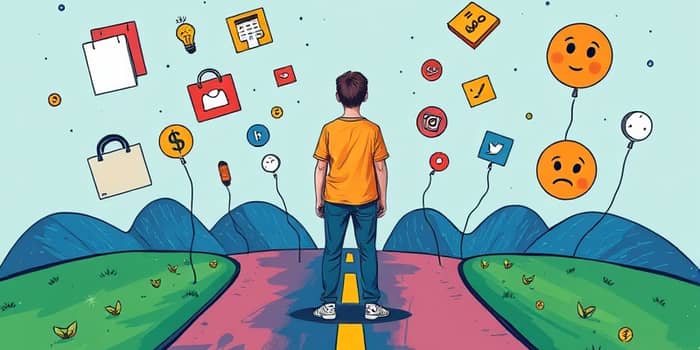Every dollar we spend carries a hidden story—a tale of emotion, cognition, and social influence. Unraveling this story can empower us to make choices that support our long-term aspirations rather than fleeting whims.
Behavioral finance bridges the gap between traditional economics and human psychology, offering a realistic view of how people interact with money in unpredictable situations.
Definition and Scope of Behavioral Finance
Behavioral finance examines the intersection of emotion and economics, challenging the assumption that individuals always act in a rational, utility-maximizing manner. Instead, it shows that decisions often stem from subconscious processes and emotional reactions.
The field has deep roots, starting with George Seldon’s “Psychology of the Stock Market” in 1912 and expanding significantly after Daniel Kahneman and Amos Tversky introduced prospect theory in 1979. Their work demonstrated that people perceive gains and losses in a nonlinear fashion, valuing potential losses more than equivalent gains.
Over the decades, scholars like Richard Thaler added concepts such as mental accounting, further enriching our comprehension of financial behavior and inspiring innovations in policy and personal finance.
Key Behavioral Finance Theories and Concepts
At the core of this discipline lie foundational theories that describe how our minds handle financial decisions:
These ideas have been validated through experiments and market observations, illuminating why bubbles form, why retail therapy feels so compelling, and why people struggle to maintain budgets.
Psychological Drivers of Spending
Understanding the internal mechanisms that drive spending empowers us to introduce effective interventions. Below are some of the most potent psychological forces at play:
- dopamine-driven reward mechanisms in the brain: When we anticipate or receive a purchase, neural circuits light up, reinforcing the desire to repeat the behavior.
- Emotional state influences: Feelings of boredom, anxiety, or loneliness can trigger unexpected online orders or in-person splurges.
- Convenience and habit loops: The ease of one-click shopping and targeted ads can create automatic spending patterns without conscious evaluation.
- hedonic pleasure and impulsive gratification: The fleeting joy from an unplanned purchase can feel more motivating than the abstract benefits of saving or investing.
These drivers often operate below conscious awareness, which makes reflection and tracking crucial for identifying unhealthy habits.
Social Influences on Spending
No experience illustrates the power of social dynamics better than the rise of influencer culture. Carefully curated images of luxury vacations, designer goods, and gourmet meals create a compelling narrative that can reshape our own spending priorities.
- Social comparison: Continuously comparing ourselves to highlight reels can lead to oversized budgets for social activities, fashion, or travel.
- FOMO (Fear of Missing Out): Limited-time deals and flash sales tap into our anxiety about being excluded, pushing us to buy things we neither need nor deeply desire.
- Peer-driven norms: In group settings, individuals may feel compelled to match the spending levels of friends, whether at a restaurant or during a vacation.
Data from a Charles Schwab survey in 2019 revealed that over one-third of Americans admit to spending beyond their means to impress others, highlighting the tangible blend of social pressure and financial decision making.
Common Cognitive Biases Affecting Spending
Biases are mental shortcuts that can lead to systematic errors in financial decisions:
Loss aversion can cause an investor to hold onto underperforming assets longer than is prudent or to overspend to prevent a perceived setback.
Overconfidence makes savers and investors overestimate their ability to time markets or manage debt, sometimes resulting in precarious financial positions.
Anchoring bias sets an arbitrary starting point—like the original price tag of an item—biasing our perception of value even when discounts or alternatives exist.
Herd mentality catalyzes group behavior, such as panic selling or buying into irrational market rallies, amplifying volatility.
Impact on Personal Finance
The consequences of unchecked behavioral biases and emotional triggers are significant. Impulse purchases can create spirals of credit card debt, erode emergency savings, and add stress to daily life.
In one study, participants with easy access to retail credit cards reported higher levels of anxiety and lower overall life satisfaction than those who maintained strict spending controls. This underlines the deep connection between our emotional well-being and financial health.
Long-term consequences include delayed retirement savings, increased borrowing costs, and diminished capacity to absorb economic shocks—all outcomes that can be mitigated through awareness and strategy.
Practical Solutions and Mindful Money Habits
Transforming financial behavior is an ongoing journey that involves both self-awareness and concrete tactics. Consider the following approaches:
- mindful spending and long-term goals: Keep a journal of purchases and motivations, aligning each expense with your broader vision of financial security.
- Budget architecture: Allocate specific percentages of income to fixed costs, discretionary spending, and savings, then automate transfers to enforce discipline.
- pause-and-reflect purchasing decision process: Implement a rule to wait 24 to 48 hours before making non-essential purchases, curbing impulse buys.
- Emotional check-ins: Before online shopping or a trip to the mall, assess your emotional state and consider alternative coping mechanisms, such as exercise or conversation.
Regularly reviewing bank statements and reflecting on emotional triggers can strengthen self-control and gradually weaken the allure of impulsive spending.
Noteworthy Figures and Real-World Implications
Pioneers like Daniel Kahneman, Amos Tversky, and Richard Thaler have not only shaped academic discourse but also influenced practical tools—such as retirement plan defaults, spending alerts, and choice architecture—that guide millions toward healthier financial behaviors.
In the marketplace, behavioral insights inform product design, marketing strategies, and regulatory proposals aimed at safeguarding consumers from predatory practices.
On a personal level, understanding the psychology of spending equips us to architect environments—both digital and physical—that minimize unnecessary temptations and reinforce beneficial habits.
Ultimately, by embracing the principles of behavioral finance, individuals can navigate the complex emotional landscape of money with greater clarity, resilience, and intention.
The path to financial well-being is not a straight line; it is a dynamic process shaped by thought, emotion, and social context. Armed with insight and self-awareness, we can transform how we relate to money and build a foundation for lasting prosperity.
References
- https://online.mason.wm.edu/blog/what-is-behavioral-finance
- https://www.stmarysbank.com/learn/tools---resources/blog/detail/the-psychology-of-spending-and-how-to-manage-it
- https://www.investopedia.com/terms/b/behavioralfinance.asp
- https://zinniawealth.com/2024/07/05/the-psychology-of-spending-mindful-money-habits/
- https://foundation99.org/2023/07/06/the-psychology-of-money/
- https://www.elevationfinancial.com/psychology-behind-overspending
- https://www.geeksforgeeks.org/finance/behavioral-finance-meaning-psychology-concept-importance/
- https://getremynt.com/blog/the-psychology-of-spending-understanding-your-money-mindset/










